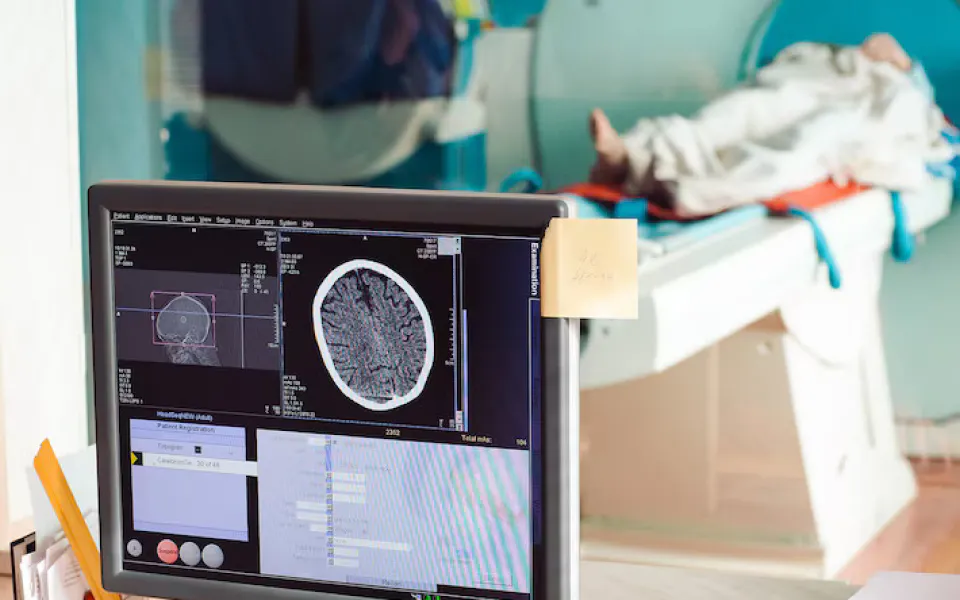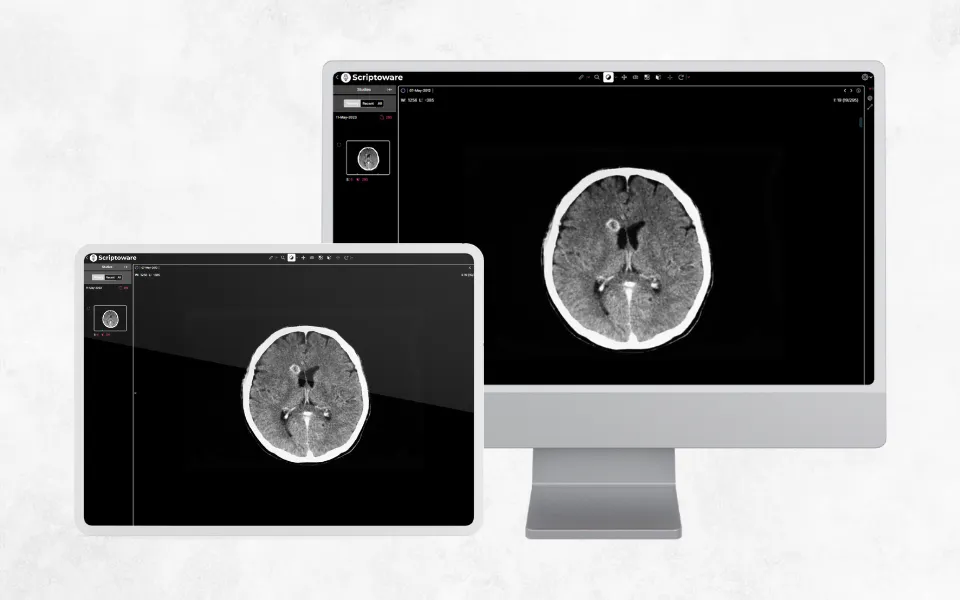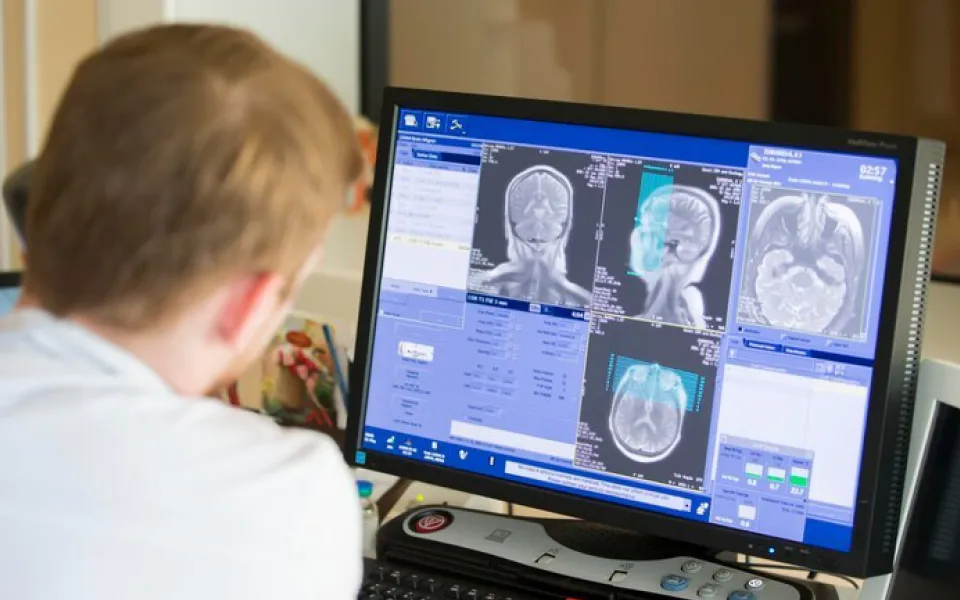Advances in medical imaging technologies such as MRI, CT scans, X-rays, and ultrasound have revolutionized healthcare diagnostics and treatment by providing detailed internal body visuals. These innovations greatly contribute to enhancing patient care outcomes.
To fully leverage these imaging tools, it is vital to have a universal set of standards that govern the storage, transmission, and display of medical images across various devices and healthcare facilities. In healthcare systems across North America from small clinics in rural areas to extensive hospital networks DICOM (Digital Imaging and Communications in Medicine) serves as the foundational protocol that ensures compatibility and efficient handling of medical imaging data.
Access and share your medical images effortlessly with Scriptoware’s DICOM Image Viewer.
Try Now !What is DICOM and Why is it Vital for Radiology?
Understanding the DICOM Standard
DICOM, or Digital Imaging and Communications in Medicine, is the internationally recognized framework for managing, sharing, and storing medical imaging data. It allows diverse imaging equipment ranging from CT scanners to MRI machines to seamlessly communicate with viewing applications, archives, and storage solutions.
The Origin Story of DICOM
During the 1980s, the American College of Radiology (ACR) collaborated with the National Electrical Manufacturers Association (NEMA) to create DICOM. Their objective was to eliminate the challenges posed by proprietary imaging formats, which limited interoperability between different manufacturers’ devices. By introducing a universal protocol, DICOM enabled smooth exchange of imaging data across platforms.
Why DICOM is Essential
- Interoperability Across Devices: DICOM ensures all imaging machines and systems “speak” the same language, enabling rapid and reliable transfer of medical images among devices, servers, and workstations.
- Improved Patient Care: Quick and secure image sharing accelerates diagnostic processes, allowing clinicians to focus on timely treatment.
- Efficiency and Cost Effectiveness: Standardization reduces the need for custom software and decreases administrative burdens, lowering operational costs.
Main Components of DICOM
DICOM Files and Their Metadata
Every DICOM file is made up of two crucial parts:
- The imaging content (such as an X-ray or CT scan).
- Associated metadata containing patient identification, imaging details, and other key information.
This ensures that the image data remains linked with all necessary contextual information, maintaining accuracy and safety.
DICOM Services and SOP (Service Object Pair) Classes
DICOM defines various service object pair classes that dictate how images and data sets are managed and transferred. Common services include:
- C STORE: The function to save and archive images.
- C FIND: Used to search and query image databases.
- C MOVE: Enables moving images from one system to another.
Healthcare IT teams rely on understanding these protocols to build effective and interoperable medical imaging networks.
Understanding DICOM Tags and Their Role in Medical Imaging
In medical imaging, DICOM tags refer to specific identifiers embedded within image files that carry critical information such as patient details, scanning protocols, and device specifications. These tags help ensure data remains consistent, searchable, and interoperable across diverse imaging platforms.
How DICOM Interacts with PACS A Step by Step Overview
- Image Acquisition: Imaging devices like CT or MRI scanners generate digital images encoded in the DICOM format.
- Data Transfer: These image files are securely transmitted to a Picture Archiving and Communication System (PACS) using standardized DICOM protocols for efficient storage.
- Image Access: Clinicians and radiologists retrieve these images on demand through specialized viewers compatible with DICOM standards.
- Diagnosis & Documentation: Medical professionals analyze the images, annotate findings, and integrate reports into the patient's electronic health record for comprehensive care management.
Access and share your medical images effortlessly with Scriptoware’s DICOM Image Viewer.
Try Now !Real World Scenario Remote Image Review Simplified
Imagine a radiologist located in one branch of a hospital network needing to review an MRI scan taken at a different facility. Instead of shipping physical films or dealing with incompatible software, the imaging device sends the scan directly to the centralized PACS archive. This seamless transfer enables immediate access to the images from any authorized workstation, speeding up diagnostic workflows and improving patient outcomes.
Integration with Other Healthcare Data Standards
DICOM often works in tandem with standards like HL7 and FHIR, which manage non image patient data such as lab results, medical histories, and admissions. Together, these frameworks support comprehensive data sharing across healthcare environments, providing a unified view of patient information.

Advantages for Different Healthcare Stakeholders
Hospital Leadership:
- Simplifies expansion and upgrades by supporting new imaging equipment without vendor lock in.
- Helps comply with HIPAA and other privacy regulations by ensuring secure image handling.
Radiologists & Clinicians:
- Offers detailed, standardized images and metadata that improve diagnostic accuracy.
- Facilitates easy collaboration with colleagues regardless of their physical location or device brand.
IT Teams:
- Streamlines system setup and maintenance by following standardized protocols.
- Enables integration of imaging data with broader hospital systems, reducing data redundancy.
Prioritizing Security and Regulatory Compliance
HIPAA Aligned Protections:
Implementations of DICOM within the U.S. healthcare context must include:
- Strong encryption safeguards during image transmission.
- Role based permissions controlling who can view or modify data.
- Comprehensive audit logging to track all interactions for accountability.
Safeguarding Patient Data:
Because DICOM files contain sensitive identifiers, they require storage and access protocols that match the security level of other medical records.
Global Privacy Considerations:
Healthcare providers offering cross border services or near international borders should be aware of regulations like the GDPR in the European Union. While these rules may not be directly applicable everywhere, understanding them is important as healthcare delivery becomes more global.
Typical Obstacles in Using DICOM and How to Address Them
Interoperability Issues
Older imaging equipment may output files that do not fully conform to DICOM specifications, often causing missing information or transfer failures. To fix this, healthcare providers deploy DICOM translation tools or gateways that convert and update data formats, ensuring smooth compatibility with newer systems.
Dealing with Large Image Files
Imaging techniques like CT or MRI produce very large files, which can overwhelm storage solutions and network bandwidth when accessed or saved. Advanced compression algorithms, especially those that do not compromise image quality, and caching systems are often employed to optimize storage space and improve retrieval speeds.
Avoiding Workflow Bottlenecks
When PACS systems or networks become overwhelmed during high demand periods, image processing can slow down, causing delays. Implementing load balancing and resilient infrastructure, including backup servers or cloud failover options, helps keep the system running smoothly and efficiently.

Vendor Agnostic Storage Solutions
To reduce reliance on a single equipment manufacturer, many hospitals and clinics adopt Vendor Agnostic Archives (VAAs). VAAs store medical images in universal, open formats free from proprietary limitations, making it easier to switch vendors or integrate new systems without compatibility problems.
How DICOM is Evolving with Technology
AI Integration
Artificial intelligence relies on consistent, standardized imaging data. Because DICOM ensures uniform metadata and pixel data, AI tools such as those used for automated lesion detection or image segmentation can be trained effectively, helping clinicians improve diagnosis accuracy.
Cloud Based Accessibility
With telemedicine's growth, cloud hosted DICOM services have become essential, enabling healthcare workers to securely access and share images regardless of location. This reduces the need for costly local infrastructure and enhances remote collaboration.
Continuous Standard Updates
DICOM standards are regularly revised to support emerging imaging technologies. As virtual and augmented reality become part of medical visualization, future DICOM versions will accommodate these advanced formats to maintain state of the art interoperability.
End data silos with Scriptoware’s VAA.
Try Now !Real World DICOM Applications
Multi Hospital Systems
When several hospitals are part of a network, DICOM enables imaging devices to send scans directly to centralized archives. Doctors can instantly retrieve images from any authorized terminal, expediting diagnosis and treatment.
Specialty Clinics and Smaller Practices
Even small scale clinics such as cardiology centers benefit from DICOM by DICOM compatible sharing images seamlessly with external specialists or larger medical centers, ensuring prompt consultations without compatibility hurdles.
Rural Healthcare and Telemedicine
Clinics in remote locations upload imaging studies to secure cloud storage, allowing radiologists in urban centers to review and interpret scans remotely, improving patient outcomes by delivering timely diagnoses.

Frequently Asked Questions about DICOM
- Is DICOM only for radiology?
No, it supports a wide variety of imaging modalities including dental, ophthalmic, and cardiac imaging. - How does DICOM maintain HIPAA
compliance?
Through data encryption, user access controls, and comprehensive audit logging to protect patient privacy. - What is the difference between DICOM and
PACS?
PACS refers to the storage and management system for medical images, while DICOM is the standardized communication protocol enabling interoperability between devices and systems. - Do I require special hardware for
DICOM?
Yes, adequate server capacity, networking infrastructure, and DICOM compatible viewers on workstations are necessary. Cloud solutions can minimize local hardware requirements. - Are cloud based DICOM services
secure?
Trusted cloud providers implement strong encryption and comply with regulatory frameworks such as HIPAA and GDPR to safeguard patient data.
Why Healthcare Providers Should Adopt DICOM
- Ensures rapid and reliable exchange of medical images
- Helps maintain compliance with patient privacy regulations
- Facilitates seamless collaboration across multiple healthcare entities
- Supports telehealth and remote diagnostic workflows
- Provides a scalable foundation for future imaging innovations
Ready to Modernize Your Medical Imaging Setup?
Contact us to discover how advanced DICOM compatible PACS and viewing tools can enhance your facility’s operational efficiency, accuracy, and patient care quality using the latest technology.
Access and share your medical images effortlessly with Scriptoware’s DICOM Image Viewer.
Try Now !